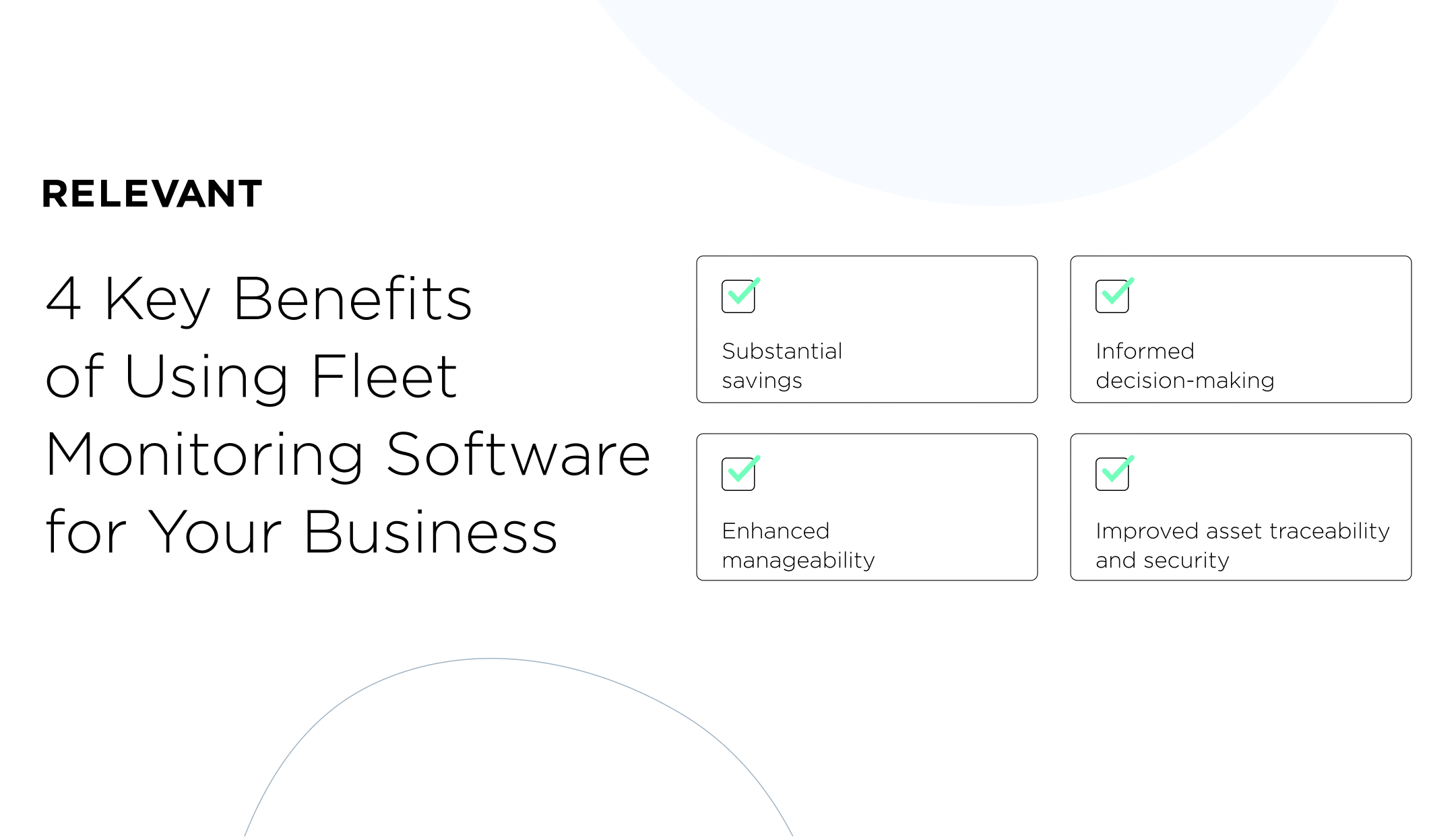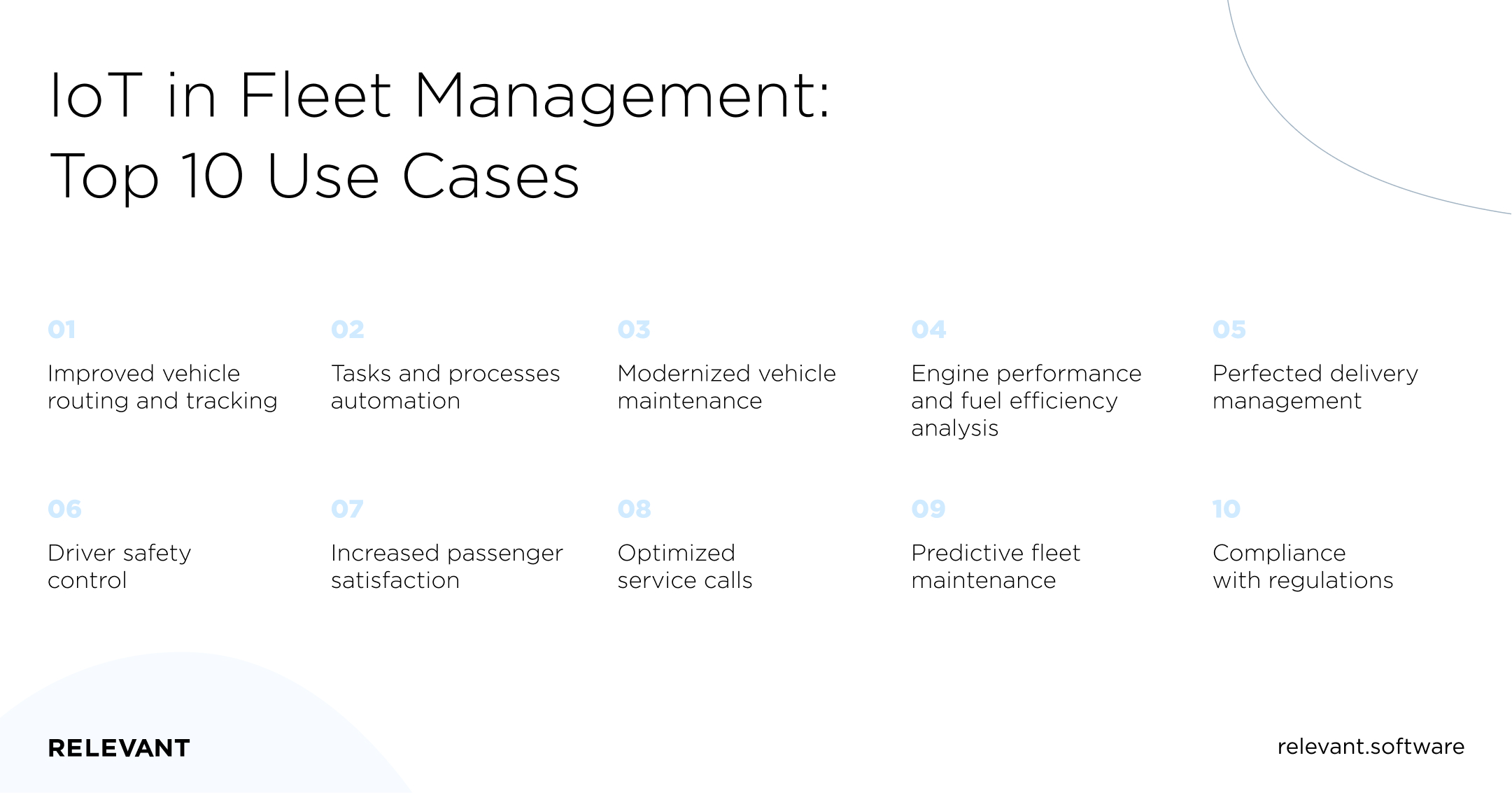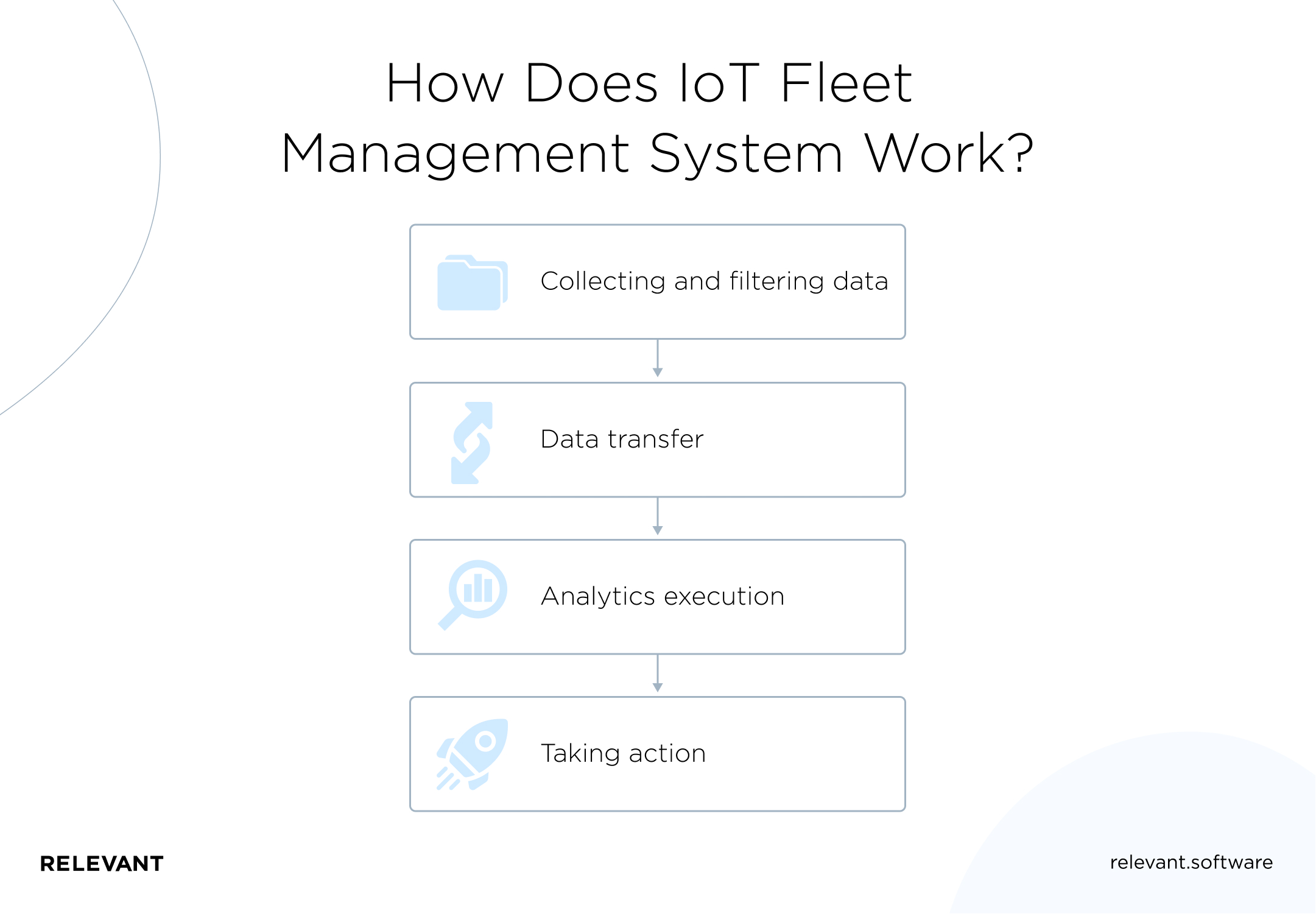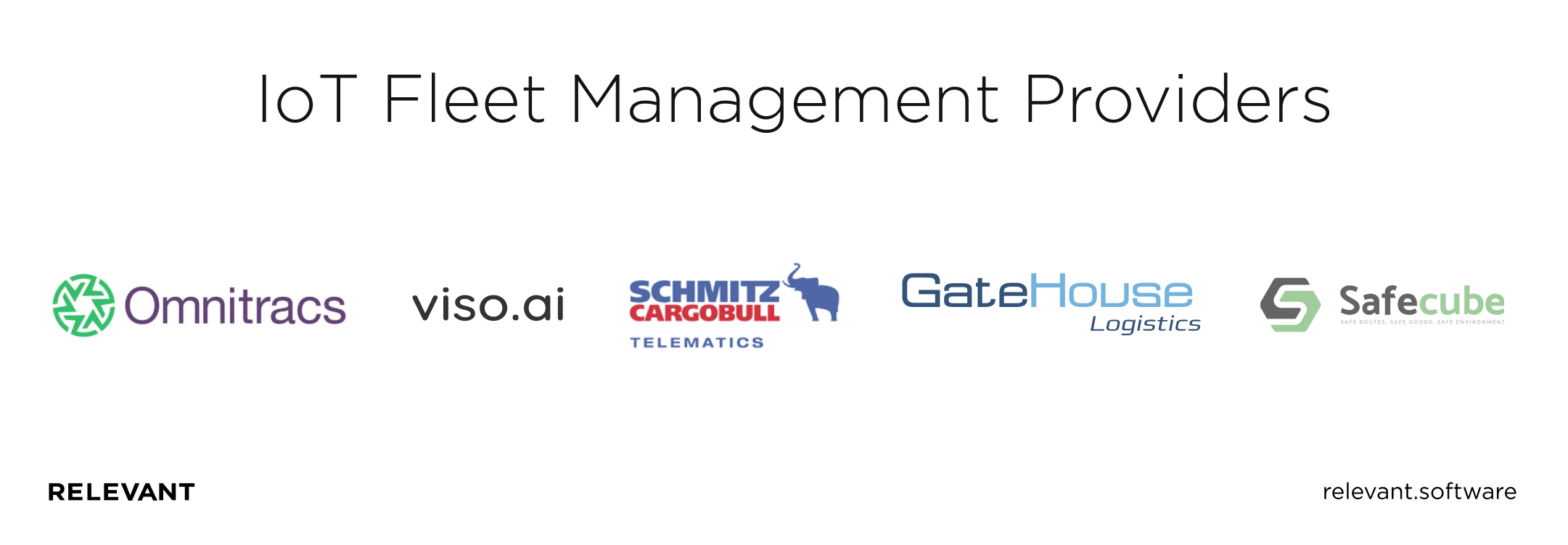IoT in Fleet Management in 2025: An Expert’s Overview
Updated: January 23, 2025
As one of the fastest-growing technological trends, the Internet of Things offers the world all the benefits of a connected infrastructure. Many companies are already actively leveraging the potential of IoT in fleet management.
And 35 billion connected objects evidence this in 2021, expected to grow to 75 billion in 2025. The trend is gaining popularity in the transport sector, where IoT technology successfully applies to fleet management.

We provide companies with senior tech talent and product development expertise to build world-class software. Let's talk about how we can help you.
Contact usWith IoT and telematics, coordination between large numbers of vehicles, previously done with cumbersome logistics, becomes more automated. Companies can easily control and monitor their assets, decide about the health and performance of their fleet, and track the status of repairs.
As Relevant specializes in IoT software development, we will detail all benefits of IoT in fleet management.
Table of Contents
Drivers of growth in the fleet management market
There have been more changes in fleet management over the past few years than in the previous decade. It facilitated this by:
- Significant increase in computing power, development of wireless communication technologies, and cloud storage. It allows exchanging large amounts of data in real-time.
- The availability of AI and machine learning technologies. They are used to providing advanced analytics, process optimization, and control.
- Mass distribution of business data. Fleet and logistics analytics, powered by sensors, telematics, and other IoT technologies, enable businesses to collect more comprehensive information.
Because of these innovations, the global fleet management market revenue could reach $16.86 billion by 2025 with a CAGR of 20.8%, up from just $3.2 million in 2016. This is a vast increase not only in the number of used solutions but also in improving the quality of services that the fleet industry provides.

A Fortune Business Insights report predicts that the global fleet management software (FMS) market will reach $46.5 million by 2025 at a CAGR of 16.52%, up from $14 million in 2018. It looks like the industry has recognized the promise of IoT technologies and is ready to invest in IoT software solutions. In addition, the widespread use of smartphones and tablets will also expand the market for device management platforms and IoT mobile apps.
Why do you need IoT technology for fleet management?
Fleet management is a complex process that covers many aspects. These are vehicle and maintenance monitoring, on the one hand, and driver management, on the other. And for fleet managers in charge of hundreds of vehicles, manually tracking devices or critical metrics can be extremely tedious, if not impossible.
Today, tables and legacy processes are still in use, but they are imprecise, cause downtime, and create communication gaps.
Intelligent fleet management solutions powered by big data, telematics, the cloud, and the IoT are game-changing for freight and transportation businesses worldwide.
The key tasks of the fleet management system are to automate manual work, increase the efficiency and productivity of the fleet, as well as ensure traffic control and driver safety. IoT solutions can provide all this for fleet management.
What are the benefits of using fleet monitoring software for your business?
Including IoT in the fleet management system aims to empower businesses while improving supply chain visibility and process chain monitoring. The technology of the Internet of Things, a software-driven collective network that connects billions of complex devices such as electronics, sensors, gateways, actuators, and platform hubs, seems to be specifically designed for fleet management.
“Smart fleet management is unlocking the true potential of IoT technology.”
Fleet management software proffers industry vehicle tracking and monitoring and driver performance, fleet analytics, fuel management and predictive maintenance, and remote diagnostics via sensors and other IoT systems.
The technology transforms traffic management by connecting vehicles and collecting a wide range of data on vehicle characteristics, routes, cargo, and passengers, while also offering government compliance. Implementation will provide such advantages as:
- Substantial savings: Telematics can predict different needs, and managers can solve problems before they become too expensive.
- Enhanced manageability: Telematics helps fleet managers track drivers, passengers, vehicle usage, and maintenance needs.
- Informed decision-making: The IoT supply chain ecosystem benefits stakeholders to leverage modern analytic technologies such as big data, AI, and machine learning on datasets generated by both in-house and third-party data sources.
- Improved asset traceability and security: Onboard and peripheral solutions provide visibility in and around the vehicle. Video recordings can be saved and used if necessary – in the event of an accident or legal proceedings.

IoT in fleet management: Top 10 use cases
Implementing IoT in fleet management is not a simple process and requires significant resources. However, once it is completed, the organization will reap such benefits:
1. Improved vehicle routing and tracking
Intelligent fleet management solutions make the best use of telematics, an IoT application designed for vehicles. It allows managers to track their fleet 24/7 and reroute vehicles as needed. This enables better scheduling, faster and more secure routing, and, as a result, lower costs. In addition, real-time visibility helps keep your finger on the pulse and quickly respond to changes in case of emergency, such as receiving immediate notifications in the event of car theft.
2. Tasks and processes automation
Automation helps build intelligent transportation systems and keep assets safe, including drivers and vehicles, at their best. Since approximately 90% of accidents are because of human error, automation is considered the ideal solution to reduce risks. By integrating with automation capabilities, smart fleet management solutions can help send automatic notifications to all connected devices.
This way, it can inform drivers in real-time in the event of a route change necessary due to traffic congestion, weather-related disruptions, or any other reason. IoT automation also helps trucks send notifications to nearby service stations and fleet operators in breakdowns or accidents.
3. Modernized vehicle maintenance
With IoT, fleet maintenance and vehicle lifecycle will not place a heavy burden on your company’s budget. Fleet management systems provide everything you need to establish a preventive maintenance schedule to help you optimize maintenance costs and extend the life of your vehicles.
Managers can track vehicle downtime caused by breakdowns, towing, and emergency repairs and identify potential problem areas and recurring patterns to help shape the best maintenance schedule. Solutions such as Oracle IoT in fleet management enable companies to integrate fleet data with existing CRM, payroll, and supply chain management systems.
4. Engine performance and fuel efficiency analysis
IoT solutions are indispensable for monitoring the operation of vehicle engines, as well as monitoring fuel efficiency. The connected devices transmit the data recorded by the digital tachograph and help find out, for example, the total distance that a particular vehicle has traveled and at what speed. Integrating IoT sensors into an existing telematics solution allows fleet managers to receive real-time information on fuel consumption. That helps to track idle speed, which not only consumes fuel but also increases emissions.
5. Perfected delivery management
Online shopping malls have extensively used the transportation industry, and the Internet of Things is driving further development. According to Inbound Logistics, using cloud-based GPS and RFID technologies, fleet managers can automate delivery times to deliver goods or parcels more efficiently and always have the correct number of vehicles on the way.
For example, the AWS IoT Fleet Management solution offers asset location tracking and notifies when an asset enters a geofence. This prepares the department for the arrival of the cargo and shortens the processing time.
6. Driver safety control
Driver safety is a priority for all fleets. The IoT uses sensors that allow fleet operators to see engine start/stop frequency, breaking behavior, accelerator mode, and even sleep mode. Fleet managers can correct unwanted behavior through driver coaching and safety training. Also, using sensors, you can track how much time drivers spend on the road and monitor their fatigue. In addition, implementing IoT traffic management solutions helps to optimize indirect costs by saving on insurance.
7. Increased passenger satisfaction
Telematics and GPS fleet tracking software can shorten delivery times and help drivers monitor their estimated arrival time.
Customer service has improved by 54% because of GPS tracking of the vehicle fleet. And contactless ticketing, newsletters, and Wi-Fi enhance the passenger experience.
8. Optimized service calls
IoT sensors housed in service-oriented devices can only signal the need for a service when there is one. This type of condition-based monitoring helps reduce service costs while improving the accuracy and quality of customer service.
9. Predictive fleet maintenance
Al-powered fleet management apps can make predictions based on direct equipment measurements and contextual data such as weather, traffic, road quality, and driver behavior. Learning of collected data makes it easy to identify specific failure scenarios based on the condition of individual vehicle parts and vehicle operating conditions. With ML, even an unprogrammed system interprets processes correctly by learning from new datasets.
10. Compliance with regulations
Because the fleet management business partners with industries subject to strict and ever-changing government regulations, such as pharmaceuticals and food, it can comply with these regulations using the Internet of Things. For example, an intelligent supply chain generates reliable temperature range control data for weather-sensitive products or drugs and monitors shipments that need to be made within a specified time window. The sensors can even monitor the climate inside the car so that perishable food is delivered safe and sound.

Besides fleet owners, the benefits of fleet management connectivity extend to:
- Service workshops. With preventive maintenance telematics, service workshops can plan their time and work more efficiently.
- Passengers. Solutions such as contactless ticketing, video surveillance, passenger information, and Wi-Fi services in public transport systems can increase passenger comfort. Telematics can also track when interior parts such as seats or handles need repair or replacement.
- Insurance companies. With the help of telematics, cars get into fewer accidents, and thus insurance companies can save on claims payments. In addition, insurers can use telematics data to build their statistical portfolios.
- Telematics service providers. They can use telematics to offer better services, such as video-based systems.
- Advertisers. Commercial vehicle infotainment systems may advertise related products or recommend nearby destinations.
Which IoT technologies are used to manage your fleet?
The IoT in fleet management is based on three fundamental technologies: GPS, RFID, and OBD II. While the former two provide vital vehicle data and statistics in real-time, the latter helps you track and manage assets.
- GPS provides access to vital vehicle-related statistics and data in real-time. This technology also helps track and manage vehicles and assets in the event of an emergency. GPS fleet tracking users are reporting positive ROI in less than six months.
- RFID comprises wireless microchips attached to an object and emitting radio waves. Readers can automatically track, identify and control the marked objects and connect the RFID reader to the Internet terminal in real-time.
- OBD is an on-board diagnostic system that closely monitors and adjusts the vehicle’s performance. It transmits data on the operation of all systems and monitors engine-related problems.
The list of all kinds of sensors and new communication technologies for fleet managers is constantly growing. Telematics technology supports multiple devices, from electronic recording devices to video cameras and temperature sensors. These devices connect wirelessly to the vehicle to track movement, location, status, and performance.
How does the IoT fleet management system work?
Adopting IoT technology brings many benefits, from fuel management to GPS trackers in vehicles. However, it requires a reliable infrastructure to run smoothly. Before implementing IoT solutions, fleet owners and fleet IoT solution providers should:
- Ensure standards for compatibility and scalability.
- Connect to cellular networks via various networks such as 2G, 3G, and 4G / LTE.
- Equip cars or other types of transport with wireless technologies and sensors.
- Implement and use the protocols and interoperability solutions.
A typical IoT fleet management system does:
Collecting and filtering data
IoT Big Data solutions can collect a vast amount of data. For example, data related to fleet IoT management may include:
- vehicle location and speed, idle;
- driver behavior;
- monitoring data for load, temperature, and fuel.
Vehicle data is collected using GPS and OBD II sensors. While the vehicle is in motion, the sensors send data to the local gateway via the mobile data connection. The gateway sends information to the web server, collects speed, location, direction, and other variables on the webserver, and sends them to a secure application server in the cloud. The application server then sends reports and warnings about vehicle driving and safety to the mobile phone of the boss or driver.
Data transfer
The collected data is sent over the Internet to the cloud for storage or other devices for further action. The transmission medium used for data transmission depends on the choice of users. Communication methods include Wi-Fi, NFC, Bluetooth, RFID system, GSM, LoRaWAN, etc.
Analytics execution
IoT big data is processed using artificial intelligence. Comprehensive information about speeding or idling, drivers’ compliance with laws, driving modes is analyzed and visualized on a single panel, which can help in making quick decisions.
Action
The last step is the actions of an automatic or a person based on data collected by fleet management telematics solutions. For example, when a sensor sends a warning that the temperature level is low, the air conditioner momentarily takes action and stabilizes the situation.

IoT in fleet management real-life use cases
Today’s use of the Internet of Things often involves a more complex scenario than was anticipated for earlier solutions. But the level of technology allows us to respond to any business challenge.
Omnitracs
Omnitracs, a provider of SaaS fleet management and data analytics solutions and a pioneer in transportation technology, has released SmartSense for inconsiderate driving. Integrated cab-facing cameras and SmartSense for inattentive driving use AI and computer vision to detect drowsiness, smoking, cell phone use, and general inattention, alerting drivers to take action to avoid a collision.
Viso.ai
Viso.ai has partnered with Intel to create a vision-based solution for asset safety and vehicle operations. Built-in 360-degree cameras and sensors that help high-resolution streams vehicles avoid accidents and theft by automatically detecting anomalies around the car.
Schmitz Cargobull Telematics and GateHouse Logistics
Another use case was implemented by Magna, a BMW Group vehicle assembly partner. Schmitz Cargobull Telematics and GateHouse Logistics have developed a long-distance tracking solution, exactly in sequence (LD-JIS). As cars become more individualized, LD-JIS-based manufacturing allows automakers to supply the right parts at the exact time in the production chain to minimize inventory. GateHouse Logistics data fusion technology gives Magna a single view of all vehicles.
Safecube
French company Safecube, created in 2019 as a result of a joint venture between Michelin, Sigfox, and Argon, launched an asset tracking system using Azure IoT fleet management. With trackers located on assets and connected to the Sigfox 0G network, managers track the exact location of a trailer, pallet, or industrial geolocation tool in real-time.

How can Relevant help you grow your business?
Ready-made solutions do not always satisfy the need for individual settings, taking into account the specifics of your business. Therefore, you can follow the example of many large companies from the Fortune 500 list outsourcing software development to Ukraine, where they get an individual solution at a reasonable price.
Relevant Software specializes in software development, including for the Internet of Things. Therefore, we can consider all your requirements and apply an exhaustive set of technologies – regardless of whether you are starting your journey to the Internet of Things or trying to scale an existing model.
To help you get the most out of your fleet maintenance software, we offer a flexible, hardware-agnostic fleet management IoT architecture to connect all assets – sensors, items, containers, equipment, vehicles, and employees. That allows you to manage your entire logistics infrastructure as a single business unit.
We can build an IoT dashboard for you that collects all data related to the vehicle fleet. In addition, our IoT software efficiently analyzes incoming data, is compatible with gadgets, and is geofenced. If desired, we can equip your custom-made solution with advanced technologies such as augmented reality, blockchain, and cognitive recognition to optimize your fleet management strategy.
IoT fleet monitoring cloud will help make your operations more cost-efficient and sustainable (for this purpose, you can use Microsoft Azure). Fleet management IoT collects a lot of sensitive data, and Relevant will take care of their safety.
Conclusion
IoT in fleet management is indispensable for improving the financial performance of businesses. And as the technology becomes more advanced, the features it offers go far beyond the intended scope. Therefore, fleet management professionals moving from simple inventory and location tracking to more complex requirements are already implementing IoT solutions for fleet management.
The benefits of a successful implementation are definitely worth the effort. However, building a reliable IoT product requires a professional team, which Relevant Software is. With us, companies and startups bring to life the most daring projects of the Internet of Things. Therefore, if you are looking for a permanent technology partner or want to hire IoT developers to help you create your custom fleet solution, contact us now.
FAQ
Our core services:
Do you want a price estimate for your project?
Do you know that we helped 200+ companies build web/mobile apps and scale dev teams?
Let's talk about your engineering needs.
Write to us











